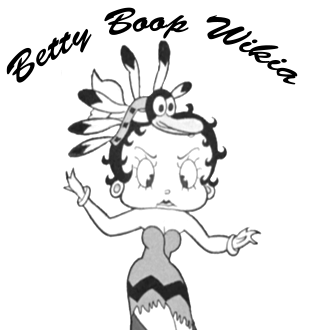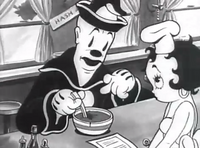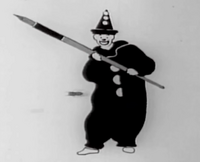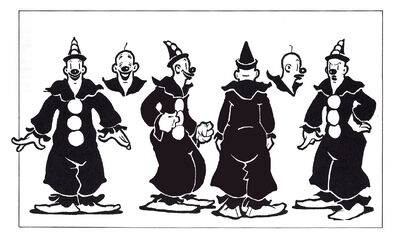| Koko the Clown |
|---|
| Koko the Clown | |
|---|---|
|
Status |
Alive |
|
Gender |
Male |
|
Species |
Human |
|
Family |
|
|
Actor |
|
|
First Appearance |
|
|
Last Appearance |
|
|
Latest Appearance |
|
Koko the Clown originated when Max Fleischer invented the rotoscope, a device which allowed for animation to be more lifelike by tracing motion picture footage of human movement. To test out his new invention Fleischer photographed his brother Dave in a clown costume. After tracing the film footage amounting to 2,500 drawings and a year's work Koko the Clown was born and appeared in a cartoons from 1919-1929. Koko's last silent film was Chemical Koko. The Fleischer Studios launched a new series called Talkartoons featuring a majority of characters including Bimbo who not only replaced Koko’s silent dog friend Fitz, but also had adventures of his own and quickly became a star in his own right. It was in a Talkartoons film with Bimbo in the leading role that Betty Boop made her first appearance in 1930 and later became the Studios headliner. Koko was later merged into the Betty Boop series starting from 1931. In the Betty Boop series he is best friends with Bimbo the dog and is usually paired up with him. In some cartoons Koko is sometimes romantically linked to Betty Boop as seen in Betty Boop's Penthouse where he envisions himself marrying her. In some of the cartoons he finds Betty attractive, whereas in some of his appearances he does not. In some of the Betty Boop cartoons Koko is a background character. In Betty Boop's Hollywood Mystery he has a crush on Lola DaVille.
Quotes
- Koko the Clown: "The poor...H...H...Herring shot?" (The Herring Murder Case)
- Koko the Clown: "C'mon help!" (The Herring Murder Case)
- Koko the Clown: "I...g...g...gotta get Bimbo the detective." (The Herring Murder Case)
- Koko the Clown: "I'll save ya!" (Boop-Oop-a-Doop)
- Koko the Clown: "A bowl of hot soup!" (Betty Boop's Bizzy Bee)
- Koko the Clown: "Sally's right Bimbo, Betty's most likely tuckered out what with the extra shifts. She works at the club, on top of her dancing and singing lessons... plus looking after he poor ol' Grampy." (Dynamite Digital Comics)
- Koko the Clown: "Aw, leave him be Sal, he's got good taste." (Dynamite Digital Comics)
- Koko the Clown: "Yes indeedy! She's quite the hoofer..." (Dynamite Digital Comics)
Voice Actors
- Cab Calloway (Singing)
- Claude Reese (1931-1933)
- Larry Storch (1960s)
- Danny Bravin (1980)
Character Design
Trivia
- Koko's best-known role was as back-up to Betty Boop in Snow White, which came out more than four years before the Disney version. In it, the Clown who has been turned into a ghost by the Wicked Queen lip-synchs to Cab Calloway's "Saint James Infirmary", while morphing into various objects mentioned in the song. Since Koko was mostly a silent star, it's one of the few classic-era cartoons in which he had any voice at all.
- Koko got a new lease on life in 1955, when Paramount Pictures, which by then owned the old Fleischer Studio's assets, sold his cartoons to television. The silent ones were of little use in that venue, but his 1930s appearances with Betty Boop were quite viable at least, as long as black and white cartoons were broadcastable, after which he faded into limbo again.
- Koko's last gasp came in TV's 1961-62 season, when a new series of "Out of the Inkwell" cartoons was made for syndication. In this one, character actor Larry Storch, whose animation credits include a couple of minor Looney Toons characters of the 1960s such as Cool Cat and Merlin the Magic Mouse, provided the Clown's voice and those of most other characters. Koko had a female counterpart, Kokette, and a dog, Kokonut. Max Fleischer, still alive and pushing 80, was said to be displeased with the quality of its animation. Today, it is mercifully forgotten.
- Koko's old films, however, remain dated, seldom seen, and compared to modern technology, more than a little primitive. But they can still be found in video bargain bins and out-of-the-way cable stations, and are still cherished by those who love creativity in cartoons.
- Koko has a small cameo in Who Framed Roger Rabbit.
- In Betty Boop's Hollywood Mystery Koko is a silent character and cannot speak, which is a reference to his appearances in his original series which debuted in the 1920s, whereas in the Betty Boop cartoon series Koko is able to speak.
























